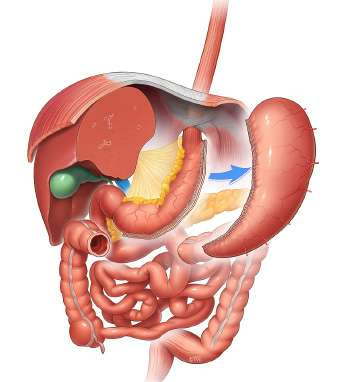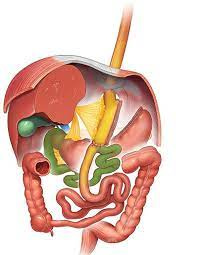Overview
RYGB Gastric bypass, sleeve gastrectomy, Mini gastric bypass MGB & other weight-loss surgeries are known collectively as bariatric surgery. Bariatric surgery involves making changes to your digestive system to help you lose weight. Bariatric surgery is done when diet and exercise haven’t worked or when you have serious health problems because of your weight. Some procedures limit how much you can eat. Other procedures work by reducing the body’s ability to absorb nutrients. Some procedures do both.
While bariatric surgery can offer many benefits, all forms of weight-loss surgery are major life-altering events and you should be well read about them. Also, you must make permanent healthy changes to your diet and get regular exercise to help ensure the long-term success of bariatric surgery
Types of Bariatric surgery
- Mini gastric bypass( MGB)
- Gastric bypass (Roux-en-Y)
- Sleeve gastrectomy

SLEEVE GASTRECTOMY

MINI GASTRIC BYPASS
Why Bariatric surgery is done
Bariatric surgery is done to help you lose excess weight and reduce your risk of potentially life-threatening weight-related health problems, including:
- Heart disease and stroke
- High blood pressure
- Nonalcoholic fatty liver disease (NAFLD) or nonalcoholic steatohepatitis (NASH)
- Sleep apnea
- Type 2 diabetes
Bariatric surgery is typically done only after you’ve tried to lose weight by improving your diet and exercise habits.
Who it’s for
In general, bariatric surgery could be an option for you if:
- Your body mass index (BMI) is 40 or higher (extreme obesity).
- Your BMI is 35 to 39.9 (obesity), and you have a serious weight-related health problems, such as type 2 diabetes, high blood pressure, or severe sleep apnea. In some cases, you may qualify for certain types of weight-loss surgery if your BMI is 30 to 34 and you have serious weight-related health problems.
BMI
Body mass index (BMI) is a person’s weight in kilograms divided by the square of height in meters. BMI is an inexpensive and easy screening method for weight categories—underweight, healthy weight, overweight, and obesity.
BMI does not measure body fat directly, but BMI is moderately correlated with more direct measures of body fat. Furthermore, BMI appears to be as strongly correlated with various metabolic and disease outcomes as these more direct measures of body fatness
How is BMI calculated?
BMI is calculated the same way for both adults and children. The calculation is based on the following formulas:
| Measurement Units | Formula and Calculation |
|---|---|
| Kilograms and meters (or centimeters) | Formula: weight (kg) / [height (m)]2 With the metric system, the formula for BMI is weight in kilograms divided by height in meters squared. Because height is commonly measured in centimeters, divide height in centimeters by 100 to obtain height in meters.Example: Weight = 68 kg, Height = 165 cm (1.65 m) Calculation: 68 ÷ (1.65)2 = 24.98 |
Bariatric surgery isn’t for everyone who is severely overweight. You may need to meet certain medical guidelines to qualify for weight-loss surgery. You likely will have an extensive screening process to see if you qualify. You must also be willing to make permanent changes to lead a healthier lifestyle.
You may be required to participate in long-term follow-up plans that include monitoring your nutrition, your lifestyle and behavior, and your medical conditions.
Risks
As with any major procedure, bariatric surgery poses some health risks
Risks associated with the surgical procedure can include:
- Excessive bleeding
- Infection
- Adverse reactions to anesthesia
- Blood clots
- Lung or breathing problems
- Leaks in your gastrointestinal system
Longer term risks and complications of weight-loss surgery vary depending on the type of surgery. They can include:
- Dumping syndrome, which leads to diarrhea, flushing, lightheadedness, nausea or vomiting
- Gallstones
- Low blood sugar (hypoglycemia)
- Ulcers
- Vomiting
- Acid reflux
How you prepare
If you qualify for bariatric surgery, your health care team gives you instructions on how to prepare for your specific type of surgery. You may need to have various lab tests and exams before surgery. You may have restrictions on eating and drinking and which medications you can take. You may be required to start a physical activity program and to stop any tobacco use.
You may also need to prepare by planning ahead for your recovery after surgery. For instance, arrange for help at home if you think you’ll need it.
What you can expect
Bariatric surgery is done in the hospital using general anesthesia. This means you’re unconscious during the procedure.
The specifics of your surgery depend on your individual situation, the type of weight-loss surgery you have, and the hospital’s or doctor’s practices. Some weight-loss surgeries are done with traditional large, or open, incisions in your abdomen.
Today, most types of bariatric surgery are performed laparoscopically. A laparoscope is a small, tubular instrument with a camera attached. The laparoscope is inserted through small incisions in the abdomen. The tiny camera on the tip of the laparoscope allows the surgeon to see and operate inside your abdomen without making the traditional large incisions. Laparoscopic surgery can make your recovery faster and shorter, but it’s not suitable for everyone.
Surgery usually takes 1-2 hours. After surgery, you awaken in a recovery room, where medical staff monitors you for any complications. Depending on your procedure, you may need to stay a few days in the hospital.
Types of bariatric surgery
Each type of bariatric surgery has pros and cons. Be sure to talk to your doctor about them. Here’s a look at common types of bariatric surgery:
- Roux-en-Y (roo-en-wy) gastric bypass. This procedure is a common method of gastric bypass. It works by decreasing the amount of food you can eat in one sitting and reducing the absorption of nutrients. The surgeon cuts across the top of your stomach, sealing it off from the rest of your stomach. The resulting pouch is about the size of a walnut and can hold only about 30 ml of food. Normally, your stomach can hold about 3 pints of food. Then, the surgeon cuts the small intestine and sews part of it directly onto the pouch. Food then goes into this small pouch of the stomach and then directly into the small intestine sewn to it. Food bypasses most of your stomach and the first section of your small intestine, and instead enters directly into the middle part of your small intestine.
- Sleeve gastrectomy. With sleeve gastrectomy, about 80% of the stomach is removed, leaving a long, tube-like pouch. This smaller stomach can’t hold as much food. It also produces less appetite-regulating hormone ghrelin, which may lessen your desire to eat. Advantages of this procedure include significant weight loss and no rerouting of the intestines. Sleeve gastrectomy also requires a shorter hospital stay than most other procedures.
- MGB:- This is a type of gastric bypass with a longer pouch approx 150 ml and fewer alterations of connections of the small bowel. This surgery both limits how much you can eat and reduces the absorption of nutrients. It is an extremely effective surgery.
Which type of weight-loss surgery is best for you depends on your specific situation. Your surgeon will take many factors into account, including body mass index, eating habits, other health issues, previous surgeries, and the risks involved with each procedure.
After bariatric surgery
After weight-loss surgery, you generally won’t be allowed to eat for one to two days so that your stomach and digestive system can heal. You will be given intravenous fluids and nutrition. Then, you’ll follow a specific diet for a few weeks. The diet begins with liquids only, then progresses to pureed, very soft foods, and eventually to regular foods. You may have many restrictions or limits on how much and what you can eat and drink.
You’ll also have frequent medical checkups to monitor your health in the first several months after weight-loss surgery. You may need laboratory testing, blood work, and various exams.
Results
Gastric bypass and other bariatric surgeries can provide long-term weight loss. The amount of weight you lose depends on your type of surgery and your change in lifestyle habits. It may be possible to lose half, or even more, of your excess weight within two years.
In addition to weight loss, gastric bypass surgery may improve or resolve conditions often related to being overweight, including:
- Heart disease
- High blood pressure
- Obstructive sleep apnea
- Type 2 diabetes
- Nonalcoholic fatty liver disease (NAFLD) or nonalcoholic steatohepatitis (NASH)
- Gastroesophageal reflux disease (GERD)
- Osteoarthritis (joint pain)
Bariatric surgery can also improve your ability to perform routine daily activities, which could help improve your quality of life.
